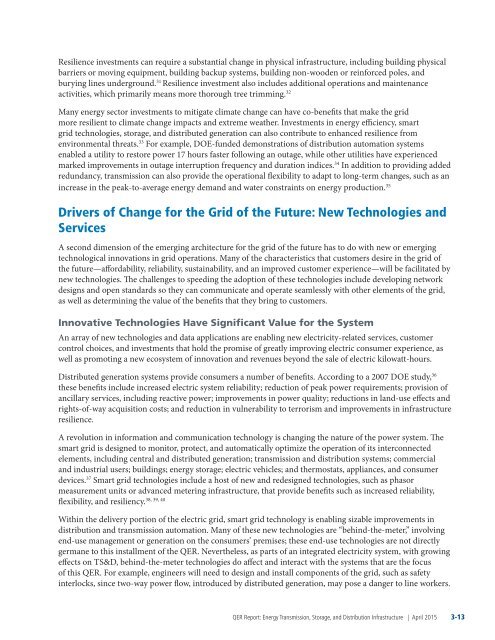LVXXU
LVXXU
LVXXU
You also want an ePaper? Increase the reach of your titles
YUMPU automatically turns print PDFs into web optimized ePapers that Google loves.
Resilience investments can require a substantial change in physical infrastructure, including building physical<br />
barriers or moving equipment, building backup systems, building non-wooden or reinforced poles, and<br />
burying lines underground. 31 Resilience investment also includes additional operations and maintenance<br />
activities, which primarily means more thorough tree trimming. 32<br />
Many energy sector investments to mitigate climate change can have co-benefits that make the grid<br />
more resilient to climate change impacts and extreme weather. Investments in energy efficiency, smart<br />
grid technologies, storage, and distributed generation can also contribute to enhanced resilience from<br />
environmental threats. 33 For example, DOE-funded demonstrations of distribution automation systems<br />
enabled a utility to restore power 17 hours faster following an outage, while other utilities have experienced<br />
marked improvements in outage interruption frequency and duration indices. 34 In addition to providing added<br />
redundancy, transmission can also provide the operational flexibility to adapt to long-term changes, such as an<br />
increase in the peak-to-average energy demand and water constraints on energy production. 35<br />
Drivers of Change for the Grid of the Future: New Technologies and<br />
Services<br />
A second dimension of the emerging architecture for the grid of the future has to do with new or emerging<br />
technological innovations in grid operations. Many of the characteristics that customers desire in the grid of<br />
the future—affordability, reliability, sustainability, and an improved customer experience—will be facilitated by<br />
new technologies. The challenges to speeding the adoption of these technologies include developing network<br />
designs and open standards so they can communicate and operate seamlessly with other elements of the grid,<br />
as well as determining the value of the benefits that they bring to customers.<br />
Innovative Technologies Have Significant Value for the System<br />
An array of new technologies and data applications are enabling new electricity-related services, customer<br />
control choices, and investments that hold the promise of greatly improving electric consumer experience, as<br />
well as promoting a new ecosystem of innovation and revenues beyond the sale of electric kilowatt-hours.<br />
Distributed generation systems provide consumers a number of benefits. According to a 2007 DOE study, 36<br />
these benefits include increased electric system reliability; reduction of peak power requirements; provision of<br />
ancillary services, including reactive power; improvements in power quality; reductions in land-use effects and<br />
rights-of-way acquisition costs; and reduction in vulnerability to terrorism and improvements in infrastructure<br />
resilience.<br />
A revolution in information and communication technology is changing the nature of the power system. The<br />
smart grid is designed to monitor, protect, and automatically optimize the operation of its interconnected<br />
elements, including central and distributed generation; transmission and distribution systems; commercial<br />
and industrial users; buildings; energy storage; electric vehicles; and thermostats, appliances, and consumer<br />
devices. 37 Smart grid technologies include a host of new and redesigned technologies, such as phasor<br />
measurement units or advanced metering infrastructure, that provide benefits such as increased reliability,<br />
38, 39, 40<br />
flexibility, and resiliency.<br />
Within the delivery portion of the electric grid, smart grid technology is enabling sizable improvements in<br />
distribution and transmission automation. Many of these new technologies are “behind-the-meter,” involving<br />
end-use management or generation on the consumers’ premises; these end-use technologies are not directly<br />
germane to this installment of the QER. Nevertheless, as parts of an integrated electricity system, with growing<br />
effects on TS&D, behind-the-meter technologies do affect and interact with the systems that are the focus<br />
of this QER. For example, engineers will need to design and install components of the grid, such as safety<br />
interlocks, since two-way power flow, introduced by distributed generation, may pose a danger to line workers.<br />
QER Report: Energy Transmission, Storage, and Distribution Infrastructure | April 2015 3-13


